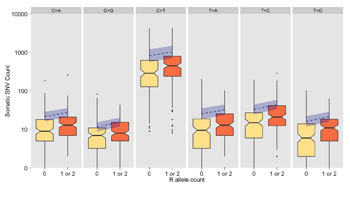Red Hair Genetics Drive Up Skin Cancer Mutations
By LabMedica International staff writers
Posted on 01 Aug 2016
An international research team has shown that gene variants associated with red hair, pale skin, and freckles are linked to a higher number of genetic mutations in cutaneous melanoma cancers. The burden of mutations associated with these variants is comparable to an extra 21 years of sun exposure in people without this variant.Posted on 01 Aug 2016
Red-haired people make up 1-2% of the world’s population; about 6% of the UK population. MC1R affects the type of melanin pigment produced, leading to red hair, freckles, pale skin, and high sun sensitivity, including a strong tendency to burn in the sun. The new research showed that even a single copy of a red hair-associated, disruptive variant (R-allele) in the melanocortin 1 receptor (MC1R) increased the number of mutations in melanoma skin cancer. Many non-red haired people carry these common variants and the study added confirmation that everyone needs to be careful about sun exposure.

Image: Distribution of single nucleotide variant (SNV) counts detected through exome sequencing of melanoma samples, grouped by the presence of R-alleles of the MC1R locus shown as a boxplot with median, quartiles, whiskers, and outliers (Image courtesy of Nature Communications).
“It has been known for a while that a person with red hair has an increased likelihood of developing skin cancer, but this is the first time that the gene has been proven to be associated with skin cancers with more mutations," said Dr David Adams, joint lead researcher, Wellcome Trust Sanger Institute (Cambridgeshire, UK), "Unexpectedly, we also showed that people with only a single copy of the gene variant still have a much higher number of tumor mutations than the rest of the population. This is one of the first examples of a common genetic profile having a large impact on a cancer genome and could help better identify people at higher risk of developing skin cancer.”
The researchers analyzed publically available datasets of tumor DNA sequences collected from over 400 people. They found an average of 42% more sun-associated mutations in tumors from people carrying the gene variant. “This is the first study to look at how the inherited MC1R gene affects the number of spontaneous mutations in skin cancers and has significant implications for understanding how skin cancers form. It has only been possible due to the large-scale data available. The tumors were sequenced in the USA, from patients all over the world and the data was made freely accessible to all researchers. This study illustrates how important international collaboration and free public access to data-sets is to research,” Prof. Tim Bishop, joint lead author, University of Leeds (Leeds, UK).
It has been thought that the type of skin pigment associated with redheads could allow more UV to reach the DNA. While this may be one mechanism of damage, the study also revealed that the MC1R gene variation not only increased the number of spontaneous mutations caused by UV light (somatic C>T mutations, a signature linked to sun exposure), but also raised the level of other (non C>T) mutations in the tumors. This suggests that biological processes exist in cancer development in people with MC1R variation that are not solely related to UV light.
“This important research explains why red-haired people have to be so careful about covering up in strong sun. It also underlines that it isn’t just people with red hair who need to protect themselves from too much sun. People who tend to burn rather than tan, or who have fair skin, hair, or eyes, or who have freckles or moles are also at higher risk," said Dr. Julie Sharp, Cancer Research UK.
The study, by Robles-Espinoza CD, Roberts ND, Chen S, et al, was published July 12, 2016, in the journal Nature Communications.
Related Links:
Wellcome Trust Sanger Institute
University of Leeds













